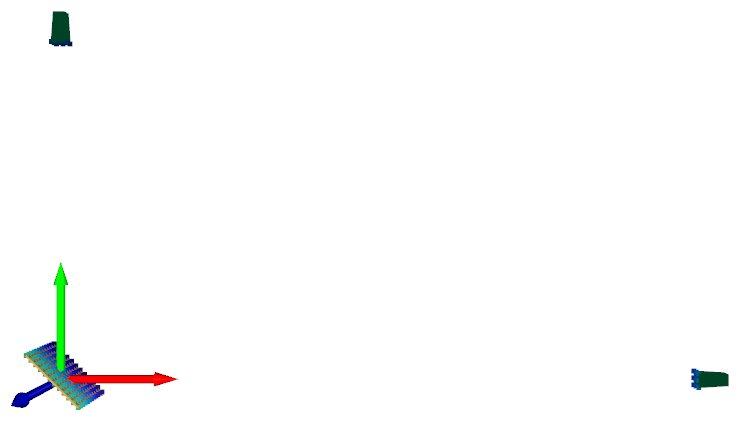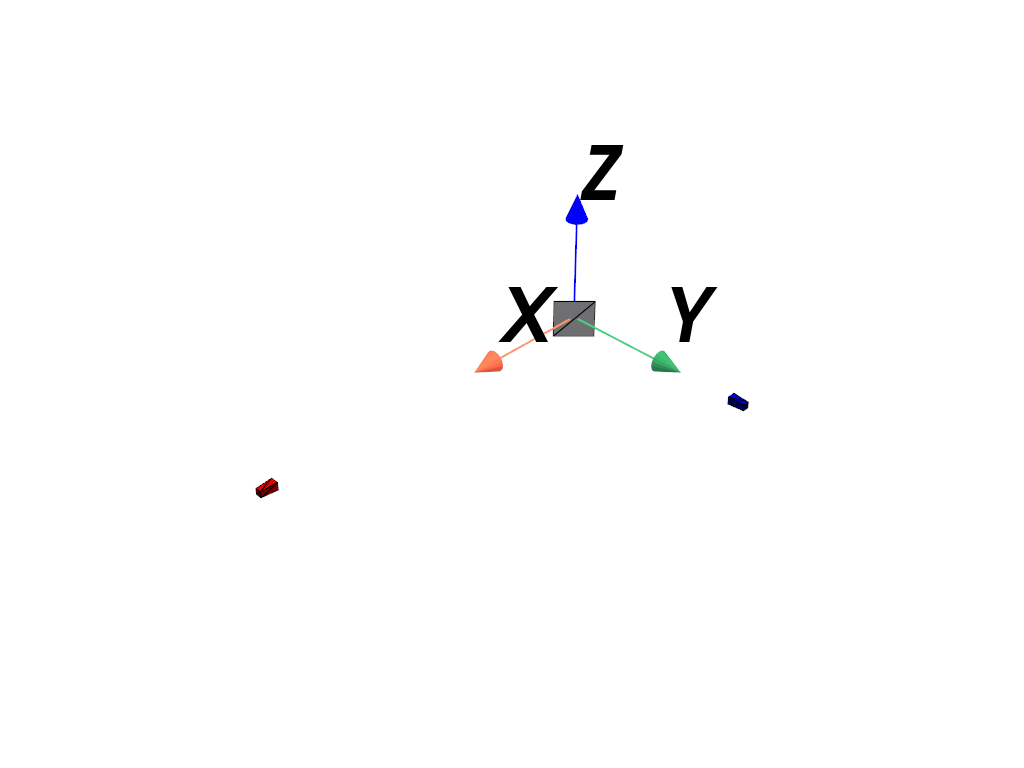Note
Click here to download the full example code
Modelling a Physical Channel in the Frequency Domain
This example uses the frequency domain lyceanem.models.frequency_domain.calculate_scattering() function to
predict the scattering parameters for the frequency and environment included in the model.
This model allows for a very wide range of antennas and antenna arrays to be considered, but for simplicity only horn
antennas will be included in this example. The simplest case would be a single source point and single receive point,
rather than an aperture antenna such as a horn.
import numpy as np
import open3d as o3d
import copy
Frequency and Mesh Resolution
freq = np.asarray(15.0e9)
wavelength = 3e8 / freq
mesh_resolution = 0.5 * wavelength
Setup transmitters and receivers
import lyceanem.geometry.targets as TL
import lyceanem.geometry.geometryfunctions as GF
transmit_horn_structure, transmitting_antenna_surface_coords = TL.meshedHorn(
58e-3, 58e-3, 128e-3, 2e-3, 0.21, mesh_resolution
)
receive_horn_structure, receiving_antenna_surface_coords = TL.meshedHorn(
58e-3, 58e-3, 128e-3, 2e-3, 0.21, mesh_resolution
)
Position Transmitter
rotate the transmitting antenna to the desired orientation, and then translate to final position.
lyceanem.geometryfunctions.open3drotate() allows both the center of rotation to be defined, and ensures the
right syntax is used for Open3d, as it was changed from 0.9.0 to 0.10.0 and onwards.
rotation_vector1 = np.radians(np.asarray([90.0, 0.0, 0.0]))
rotation_vector2 = np.radians(np.asarray([0.0, 0.0, -90.0]))
transmit_horn_structure = GF.open3drotate(
transmit_horn_structure,
o3d.geometry.TriangleMesh.get_rotation_matrix_from_xyz(rotation_vector1),
)
transmit_horn_structure = GF.open3drotate(
transmit_horn_structure,
o3d.geometry.TriangleMesh.get_rotation_matrix_from_xyz(rotation_vector2),
)
transmit_horn_structure.translate(np.asarray([2.695, 0, 0]), relative=True)
transmitting_antenna_surface_coords = GF.open3drotate(
transmitting_antenna_surface_coords,
o3d.geometry.TriangleMesh.get_rotation_matrix_from_xyz(rotation_vector1),
)
transmitting_antenna_surface_coords = GF.open3drotate(
transmitting_antenna_surface_coords,
o3d.geometry.TriangleMesh.get_rotation_matrix_from_xyz(rotation_vector2),
)
transmitting_antenna_surface_coords.translate(np.asarray([2.695, 0, 0]), relative=True)
Out:
geometry::PointCloud with 36 points.
Position Receiver
rotate the receiving horn to desired orientation and translate to final position.
receive_horn_structure = GF.open3drotate(
receive_horn_structure,
o3d.geometry.TriangleMesh.get_rotation_matrix_from_xyz(rotation_vector1),
)
receive_horn_structure.translate(np.asarray([0, 1.427, 0]), relative=True)
receiving_antenna_surface_coords = GF.open3drotate(
receiving_antenna_surface_coords,
o3d.geometry.TriangleMesh.get_rotation_matrix_from_xyz(rotation_vector1),
)
receiving_antenna_surface_coords.translate(np.asarray([0, 1.427, 0]), relative=True)
Out:
geometry::PointCloud with 36 points.
Create Scattering Plate
Create a Scattering plate a source of multipath reflections
reflectorplate, scatter_points = TL.meshedReflector(
0.3, 0.3, 6e-3, wavelength * 0.5, sides="front"
)
position_vector = np.asarray([29e-3, 0.0, 0])
rotation_vector1 = np.radians(np.asarray([0.0, 90.0, 0.0]))
scatter_points = GF.open3drotate(
scatter_points,
o3d.geometry.TriangleMesh.get_rotation_matrix_from_xyz(rotation_vector1),
)
reflectorplate = GF.open3drotate(
reflectorplate,
o3d.geometry.TriangleMesh.get_rotation_matrix_from_xyz(rotation_vector1),
)
reflectorplate.translate(position_vector, relative=True)
scatter_points.translate(position_vector, relative=True)
Out:
geometry::PointCloud with 900 points.
Specify Reflection Angle
Rotate the scattering plate to the optimum angle for reflection from the transmitting to receiving horn
plate_orientation_angle = 45.0
rotation_vector = np.radians(np.asarray([0.0, 0.0, plate_orientation_angle]))
scatter_points = GF.open3drotate(
scatter_points,
o3d.geometry.TriangleMesh.get_rotation_matrix_from_xyz(rotation_vector),
)
reflectorplate = GF.open3drotate(
reflectorplate,
o3d.geometry.TriangleMesh.get_rotation_matrix_from_xyz(rotation_vector),
)
from lyceanem.base_classes import structures
blockers = structures([reflectorplate, receive_horn_structure, transmit_horn_structure])
Visualise the Scene Geometry
Use open3d function open3d.visualization.draw_geometries() to visualise the scene and ensure that all the
relavent sources and scatter points are correct. Point normal vectors can be displayed by pressing ‘n’ while the
window is open.
mesh_frame = o3d.geometry.TriangleMesh.create_coordinate_frame(
size=0.5, origin=[0, 0, 0]
)
o3d.visualization.draw_geometries(
[
transmitting_antenna_surface_coords,
receiving_antenna_surface_coords,
scatter_points,
reflectorplate,
mesh_frame,
receive_horn_structure,
transmit_horn_structure,
]
)

Specify desired Transmit Polarisation
The transmit polarisation has a significant effect on the channel characteristics. In this example the transmit horn will be vertically polarised, (e-vector aligned with the y direction)
desired_E_axis = np.zeros((1, 3), dtype=np.float32)
desired_E_axis[0, 1] = 1.0
Frequency Domain Scattering
Once the arrangement of interest has been setup, lyceanem.models.frequency_domain.calculate_scattering() can
be called, using raycasting to calculate the scattering parameters based upon the inputs. The scattering parameter
determines how many reflections will be considered. A value of 0 would mean only line of sight contributions will be
calculated, with 1 including single reflections, and 2 including double reflections as well.
import lyceanem.models.frequency_domain as FD
Ex, Ey, Ez = FD.calculate_scattering(
aperture_coords=transmitting_antenna_surface_coords,
sink_coords=receiving_antenna_surface_coords,
antenna_solid=blockers,
desired_E_axis=desired_E_axis,
scatter_points=scatter_points,
wavelength=wavelength,
scattering=1,
)
Out:
/home/timtitan/anaconda3/envs/EMDevelopment/lib/python3.8/site-packages/numba/cuda/cudadrv/devicearray.py:885: NumbaPerformanceWarning: Host array used in CUDA kernel will incur copy overhead to/from device.
warn(NumbaPerformanceWarning(msg))
Examine Scattering
The resultant scattering is decomposed into the Ex,Ey,Ez components at the receiving antenna, by itself this is not that interesting, so for this example we will rotate the reflector back, and then create a loop to step the reflector through different angles from 0 to 90 degrees in 1 degree steps.
angle_values = np.linspace(0, 90, 91)
angle_increment = np.diff(angle_values)[0]
responsex = np.zeros((len(angle_values)), dtype="complex")
responsey = np.zeros((len(angle_values)), dtype="complex")
responsez = np.zeros((len(angle_values)), dtype="complex")
plate_orientation_angle = -45.0
rotation_vector = np.radians(
np.asarray([0.0, 0.0, plate_orientation_angle + angle_increment])
)
scatter_points = GF.open3drotate(
scatter_points,
o3d.geometry.TriangleMesh.get_rotation_matrix_from_xyz(rotation_vector),
)
reflectorplate = GF.open3drotate(
reflectorplate,
o3d.geometry.TriangleMesh.get_rotation_matrix_from_xyz(rotation_vector),
)
from tqdm import tqdm
for angle_inc in tqdm(range(len(angle_values))):
rotation_vector = np.radians(np.asarray([0.0, 0.0, angle_increment]))
scatter_points = GF.open3drotate(
scatter_points,
o3d.geometry.TriangleMesh.get_rotation_matrix_from_xyz(rotation_vector),
)
reflectorplate = GF.open3drotate(
reflectorplate,
o3d.geometry.TriangleMesh.get_rotation_matrix_from_xyz(rotation_vector),
)
Ex, Ey, Ez = FD.calculate_scattering(
aperture_coords=transmitting_antenna_surface_coords,
sink_coords=receiving_antenna_surface_coords,
antenna_solid=blockers,
desired_E_axis=desired_E_axis,
scatter_points=scatter_points,
wavelength=wavelength,
scattering=1,
)
responsex[angle_inc] = Ex
responsey[angle_inc] = Ey
responsez[angle_inc] = Ez
Out:
0%| | 0/91 [00:00<?, ?it/s]/home/timtitan/anaconda3/envs/EMDevelopment/lib/python3.8/site-packages/numba/cuda/cudadrv/devicearray.py:885: NumbaPerformanceWarning: Host array used in CUDA kernel will incur copy overhead to/from device.
warn(NumbaPerformanceWarning(msg))
1%|1 | 1/91 [00:01<01:57, 1.30s/it]
2%|2 | 2/91 [00:02<01:55, 1.30s/it]
3%|3 | 3/91 [00:03<01:54, 1.30s/it]
4%|4 | 4/91 [00:05<01:52, 1.29s/it]
5%|5 | 5/91 [00:06<01:48, 1.26s/it]
7%|6 | 6/91 [00:07<01:47, 1.26s/it]
8%|7 | 7/91 [00:08<01:45, 1.26s/it]
9%|8 | 8/91 [00:10<01:45, 1.27s/it]
10%|9 | 9/91 [00:11<01:43, 1.26s/it]
11%|# | 10/91 [00:12<01:40, 1.23s/it]
12%|#2 | 11/91 [00:13<01:36, 1.21s/it]
13%|#3 | 12/91 [00:14<01:35, 1.20s/it]
14%|#4 | 13/91 [00:16<01:33, 1.20s/it]
15%|#5 | 14/91 [00:17<01:31, 1.19s/it]
16%|#6 | 15/91 [00:18<01:29, 1.18s/it]
18%|#7 | 16/91 [00:19<01:28, 1.17s/it]
19%|#8 | 17/91 [00:20<01:26, 1.16s/it]
20%|#9 | 18/91 [00:21<01:24, 1.16s/it]
21%|## | 19/91 [00:23<01:22, 1.15s/it]
22%|##1 | 20/91 [00:24<01:21, 1.15s/it]
23%|##3 | 21/91 [00:25<01:20, 1.15s/it]
24%|##4 | 22/91 [00:26<01:18, 1.13s/it]
25%|##5 | 23/91 [00:27<01:16, 1.13s/it]
26%|##6 | 24/91 [00:28<01:15, 1.12s/it]
27%|##7 | 25/91 [00:29<01:13, 1.12s/it]
29%|##8 | 26/91 [00:30<01:12, 1.11s/it]
30%|##9 | 27/91 [00:32<01:11, 1.12s/it]
31%|### | 28/91 [00:33<01:11, 1.13s/it]
32%|###1 | 29/91 [00:34<01:11, 1.15s/it]
33%|###2 | 30/91 [00:35<01:09, 1.14s/it]
34%|###4 | 31/91 [00:36<01:08, 1.13s/it]
35%|###5 | 32/91 [00:37<01:07, 1.14s/it]
36%|###6 | 33/91 [00:38<01:06, 1.14s/it]
37%|###7 | 34/91 [00:40<01:05, 1.14s/it]
38%|###8 | 35/91 [00:41<01:05, 1.16s/it]
40%|###9 | 36/91 [00:42<01:03, 1.15s/it]
41%|#### | 37/91 [00:43<01:01, 1.14s/it]
42%|####1 | 38/91 [00:44<00:59, 1.13s/it]
43%|####2 | 39/91 [00:45<00:58, 1.12s/it]
44%|####3 | 40/91 [00:46<00:56, 1.12s/it]
45%|####5 | 41/91 [00:47<00:55, 1.12s/it]
46%|####6 | 42/91 [00:49<00:55, 1.12s/it]
47%|####7 | 43/91 [00:50<00:53, 1.11s/it]
48%|####8 | 44/91 [00:51<00:52, 1.12s/it]
49%|####9 | 45/91 [00:52<00:50, 1.11s/it]
51%|##### | 46/91 [00:53<00:49, 1.11s/it]
52%|#####1 | 47/91 [00:54<00:48, 1.10s/it]
53%|#####2 | 48/91 [00:55<00:47, 1.10s/it]
54%|#####3 | 49/91 [00:56<00:46, 1.10s/it]
55%|#####4 | 50/91 [00:57<00:45, 1.10s/it]
56%|#####6 | 51/91 [00:58<00:44, 1.11s/it]
57%|#####7 | 52/91 [01:00<00:43, 1.11s/it]
58%|#####8 | 53/91 [01:01<00:42, 1.12s/it]
59%|#####9 | 54/91 [01:02<00:41, 1.12s/it]
60%|###### | 55/91 [01:03<00:40, 1.11s/it]
62%|######1 | 56/91 [01:04<00:39, 1.11s/it]
63%|######2 | 57/91 [01:05<00:37, 1.10s/it]
64%|######3 | 58/91 [01:06<00:36, 1.09s/it]
65%|######4 | 59/91 [01:07<00:35, 1.11s/it]
66%|######5 | 60/91 [01:08<00:34, 1.12s/it]
67%|######7 | 61/91 [01:10<00:33, 1.12s/it]
68%|######8 | 62/91 [01:11<00:32, 1.10s/it]
69%|######9 | 63/91 [01:12<00:30, 1.09s/it]
70%|####### | 64/91 [01:13<00:29, 1.08s/it]
71%|#######1 | 65/91 [01:14<00:28, 1.09s/it]
73%|#######2 | 66/91 [01:15<00:27, 1.09s/it]
74%|#######3 | 67/91 [01:16<00:26, 1.09s/it]
75%|#######4 | 68/91 [01:17<00:25, 1.09s/it]
76%|#######5 | 69/91 [01:18<00:24, 1.11s/it]
77%|#######6 | 70/91 [01:19<00:23, 1.11s/it]
78%|#######8 | 71/91 [01:21<00:22, 1.11s/it]
79%|#######9 | 72/91 [01:22<00:20, 1.10s/it]
80%|######## | 73/91 [01:23<00:19, 1.09s/it]
81%|########1 | 74/91 [01:24<00:18, 1.08s/it]
82%|########2 | 75/91 [01:25<00:17, 1.09s/it]
84%|########3 | 76/91 [01:26<00:16, 1.08s/it]
85%|########4 | 77/91 [01:27<00:15, 1.08s/it]
86%|########5 | 78/91 [01:28<00:14, 1.09s/it]
87%|########6 | 79/91 [01:29<00:12, 1.08s/it]
88%|########7 | 80/91 [01:30<00:11, 1.09s/it]
89%|########9 | 81/91 [01:31<00:10, 1.10s/it]
90%|######### | 82/91 [01:32<00:09, 1.10s/it]
91%|#########1| 83/91 [01:34<00:08, 1.10s/it]
92%|#########2| 84/91 [01:35<00:07, 1.09s/it]
93%|#########3| 85/91 [01:36<00:06, 1.08s/it]
95%|#########4| 86/91 [01:37<00:05, 1.07s/it]
96%|#########5| 87/91 [01:38<00:04, 1.08s/it]
97%|#########6| 88/91 [01:39<00:03, 1.01s/it]
98%|#########7| 89/91 [01:39<00:01, 1.28it/s]
100%|##########| 91/91 [01:39<00:00, 2.23it/s]
100%|##########| 91/91 [01:39<00:00, 1.09s/it]
Plot Normalised Response
Using matplotlib, plot the results
import matplotlib.pyplot as plt
normalised_max = np.max(
np.array(
[
np.max(20 * np.log10(np.abs(responsex))),
np.max(20 * np.log10(np.abs(responsey))),
np.max(20 * np.log10(np.abs(responsez))),
]
)
)
ExdB = 20 * np.log10(np.abs(responsex)) - normalised_max
EydB = 20 * np.log10(np.abs(responsey)) - normalised_max
EzdB = 20 * np.log10(np.abs(responsez)) - normalised_max
fig, ax = plt.subplots()
ax.plot(angle_values - 45, ExdB, label="Ex")
ax.plot(angle_values - 45, EydB, label="Ey")
ax.plot(angle_values - 45, EzdB, label="Ez")
plt.xlabel("$\\theta_{N}$ (degrees)")
plt.ylabel("Normalised Level (dB)")
ax.set_ylim(-60.0, 0)
ax.set_xlim(np.min(angle_values) - 45, np.max(angle_values) - 45)
ax.set_xticks(np.linspace(np.min(angle_values) - 45, np.max(angle_values) - 45, 19))
ax.set_yticks(np.linspace(-60, 0.0, 21))
legend = ax.legend(loc="upper right", shadow=True)
plt.grid()
plt.show()

Total running time of the script: ( 2 minutes 10.079 seconds)